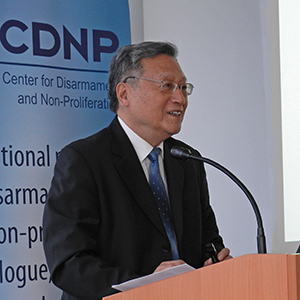

On June 26, 2013, Dr. Zhu Xuhui, advisor to the China National Nuclear Corporation, gave a presentation at the VCDNP on the development of the Chinese nuclear energy program after the March, 2011 Fukushima accident, briefly outlining the prospects for China's nuclear industry.
In 2012, the government approved a new, twelve-year plan for rapid expansion of the nuclear energy sector. Currently, China has fifteen units that produce 12.5 gigawatts (GW) of energy; twenty-six new units with 29 GW energy capacity are under construction, representing about 40 percent of total global nuclear reactor construction. As a result, by 2015, nuclear energy will increase from the current 1.5 percent to 3-4 percent of China's total energy production. By 2020, production of energy by operational nuclear power plants will reach 60 GW (5-6 percent of the entire energy production in the country), with additional 20 GW-capable reactors that will be under construction.
Dr. Zhu discussed the ways in which, after the Fukushima accident in Japan, the Chinese government introduced changes into its original plans. In particular, it decided not to build new nuclear power plants inland; relevant projects were frozen and new construction has concentrated exclusively along the coast. The earlier plans have not been completely abandoned, he explained; rather, the government decided to postpone decisions until 2015, and in the meantime, an active research program, buttressed by debates, will help better inform future decisions.

Many key elements of the future program are still being discussed, according to Dr. Zhu. For example, the target capacity of the nuclear industry has not yet been determined—it could be 60 GW, 70 GW, or even 100 GW. Similarly, no choice has been made regarding future reactors—should they build both Generation II and Generation III reactors, or concentrate entirely on Generation III? Further, no decisions have yet been made on interim storage for spent fuel or the desirability of developing fast neutron reactors.
Regarding this latter issue, he said that an experimental 65 megawatt fast reactor became operational in 2011, and that China has signed an intergovernmental agreement with Russia on the construction of two BN-800 fast reactors by 2020; however, no agreement between companies has yet been signed. Preliminary plans also foresee the completion of a commercial fast reactor by 2035, but Dr. Zhu assessed the probability of achieving that goal as low.
He also described plans for fuel production in China, noting in particular in-country production of centrifuges as well as plans for small-scale fuel reprocessing and mixed oxide capabilities. Much reprocessing infrastructure will need to be constructed in the future, and plans are likely to be adjusted as new technologies become available. Dr. Zhu emphasized the need for an interim dry storage facility as a solution for dealing with spent fuel in the meantime.

Following the Fukushima accident, China's government adopted third-generation safety standards, which take into account the 10-5 probability of reactor core meltdown and 10-6 probability of significant contamination of areas outside the reactor. Reactor safety features will include enhanced passive safety systems, double containers, and reactor core melt capturers.
In a response to a question from the audience, Dr. Zhu explained that a large-scale effort to educate the necessary cadre for the expanding nuclear industry is underway, and it is expected that there will be no lack of engineers and workers for the new facilities.
Responding to a question about the possibility for China to emphasize renewable energy sources instead of nuclear power expansion, Dr. Zhu pointed out that the country's energy needs are so significant that all avenues need to be explored and developed. He opined that China will continue to develop renewable energy but in parallel with efforts to expand and develop its nuclear energy sector.